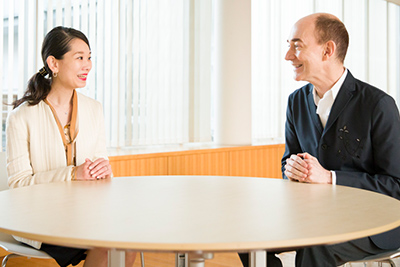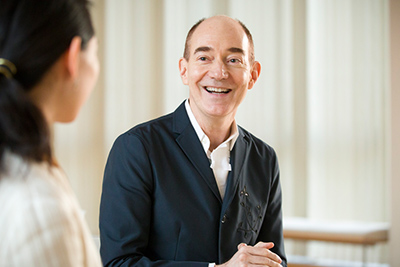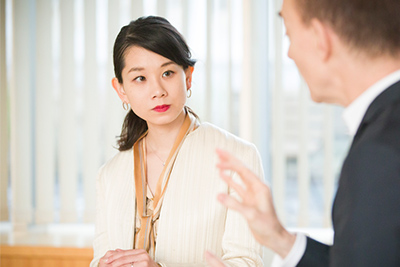Director of National Inst. of Japanese Literature Robert Campbell and Classics Interpreter Arisawa
"Sentiment towards becoming a classics interpreter"
Campbell: You carried out research at Osaka University and became a classics interpreter at the NIJL Arts Initiative from October. How did you feel when you were appointed classics interpreter?
Arisawa:
At first I was uncertain if I wanted to fill the gap between lifestyles of ancient times and today. One significant reason I was interested in this job was talking with pottery maker, Katsu Kikuchi. I was very surprised to find out he was reading a Kibyōshi story book by Kyoden Santo. I thought that there must be other artists other than Kikuchi inspired from older works as well as that it would be great to work with these kinds of people.

"First job"
Campbell: You have been a classics interpreter for 2 months. Please tell me your thoughts during work.
Arisawa: Public relations is part of a classics interpreters' work. My first job involved greeting visitors at a booth set up by inter-university research institutes called "Meet the Researchers!!" and talking about work and research fields. It was really stimulating to hear different points of view such as people saying they were interested in old books, they had old materials at home or they liked the layout of old printed books. I am sometimes uncertain about providing a proper response to many people with different interests and backgrounds.
Campbell: For example, when someone says that the plate layout of woodblock printed books in the Edo period was very beautiful, you probably have to be able to respond to that while organizing a lot of information and think about how to communicate, create and adjust.
"Experiencing radical research"
Campbell: Toppan is scanning images of various different cultural resources and carrying out radical research to deploy these through various different means such as VR and AR. You have experienced this for yourself first hand. What kind of impression did you receive?
Arisawa: I have seen a lot of different works in VR so far and I was really astonished by the new technology. I felt a strong impression of that the VR must have had a vision on how to use this technology in order to show something in a certain way, and therefore, was astonished by their use of so many expressions. Specifically, there was a beautiful VR of the details of the carvings on the Yomei Gate at Nikko Toshogu Shrine are elaborate all the way to the vivid colors on the back side which one cannot normally see making. This directly links to the Toshogu Shrine letting the viewer wonder what the meaning behind each individual carvings and pictures are as well as the meaning behind the entire gate as it is an object of faith. It seemed that not only images which cannot be made through photography are being created, but importance is placed on what can be extracted from the essence of these images.
Campbell: It is important to look at an object and wonder its meaning, its origin and how to observe it. For example, is the object for praying or is it some sort of educational material for learning. There are endless ways to think about it. What did you feel was fresh about seeing this?
Arisawa:
As it is a job, there are some things that cannot be done on our own will. It is necessary to skillfully incorporate the intentions of the client or owner. I felt that figuring out how to do this within the budget is what is required of this job. I heard that the job is not only to create, but it is also important how I elicit demands in the early stages and consider what technology is appropriate. Naturally, anything is possible technology-wise and we can use the latest technology but it is important to determine if this technology is the best option and make considerations based on each individual demand.

Campbell: Implementing what you can do as much as possible is not necessarily the best option.
"Interactions between Artists and Translators"
Campbell: The NIJL Arts Initiative aims to have artists and translators search and pursue classic literature together to discover different types of materials to utilize in expressions and objects. You play the necessary role of the interpreter in this process. We must elicit what artists and translators active in various different genres are aiming to do and have discussion after discussion to arrive at what they want. Does coming into contact with artists and holding session after session with them show any signs of possible changes in your orientation, mindset or way of selecting topics as a researcher?
Arisawa: I am researching novels called light literature from the late 18th century to the early 19th century being turned into paintings. My work focuses on Kyoden Santo. Kyoden created hit after hit over his lifetime and stood in the forefront of literature. He had a much stronger interest in literature from the past than those from the times in he was living, which I have been investigating and researching. This has posed a significant question for me. Did he want to head towards a vector which seems to be going in the opposite direction or being able to see in a non-contradictory, completely opposite direction provide synchronization?
Campbell: His journey involves going in the reserve direction to the past while depicting the current social conditions and customs in a leading manner.
Arisawa: The NIJL Arts Initiative involves artists and translators on the forefront to look at classic literature in a fresh manner as a genuinely new world, connect this to their own creative activities and observe what is being shared. I feel that this could be the genuine desire of humanity. It seems that in any generation, people refined in culture and the arts who are active on the forefront of their industry have always taken a long second look at the past, creating new expressions in their own world. I hope that by viewing such actions up close can deepen my thought process.
"Having fun with classic literature"
Campbell: What developments should the NIJL Arts Initiative make in the future?
Arisawa:
My biggest wish is that those who are not interested in the world of classic literature and find it difficult to find it interesting, change their minds increases. Many people tend to think that studying and reading classic literature as part of your everyday life is simply just to gain knowledge. This is somewhat disappointing. For example, there are mechanisms similar to metaphors in cooking, such as the appearance or decorations in which many people enjoy in various different settings. This is not completely irrelevant to the world of classical literature. The more you learn, the more fun everyday life becomes.



